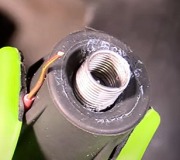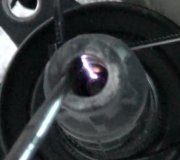Here are my readings:
I logged into my AutoZone account and got screenshots and directions of how to test and what to test. I did all these tests twice previously but once more could not hurt.
Power transistor:
1999-00 3.3L Engines
1. Disconnect the negative battery cable.
2. Disconnect the two-wire ignition coil harness connector from the distributor electrical connector.
3. Disconnect the six-wire distributor harness connector from the distributor.
4. Connect the digital ohmmeter leads to pin 2 of the six-pin distributor terminal, and to the green wire (pin 2) terminal of the two-wire distributor electrical connector. If the resistance is 0 ohms, replace the distributor. I measured infinity, or an open.
Ignition Coil:
1. Disconnect the negative battery cable.
2. Disconnect the two-wire ignition coil harness connector from the distributor electrical connector.
3. Connect ohmmeter leads to pins 1 and 2 at the distributor electrical connector. The resistance should be 0.5-1 ohm. - I measured 0.9 ohms.
If it is within specifications, continue by testing the secondary winding resistance.
4. Remove the distributor cap and position it aside.
5. Connect ohmmeter leads to distributor electrical connector pin 1 and the coil tower metal tip on the distributor. The resistance should be approximately 12,000 (12k) ohms. If it is not, replace the distributor. I measured 10.9K ohms, not much different.
Resistor:
I am not sure about the resistor. My data says.
"The resistor is located near the distributor connector on 3.3L engines. It has a two-wire connector and is taped to the harness." Not clear to me but I have a print out of the 2 wire Ignition Coil connector and the resistor is inline on Pin 2. So I went to the female side of the coil harness connector and measured across pins 1 and 2. I received an open. There is something taped over on the cable - should I remove the tape to get to the resistor? I am not sure about where the resistor is. Is it in the distributor, if it is what does step 3 mean?
SPONSORED LINKS
Tuesday, November 2nd, 2010 AT 1:11 AM




